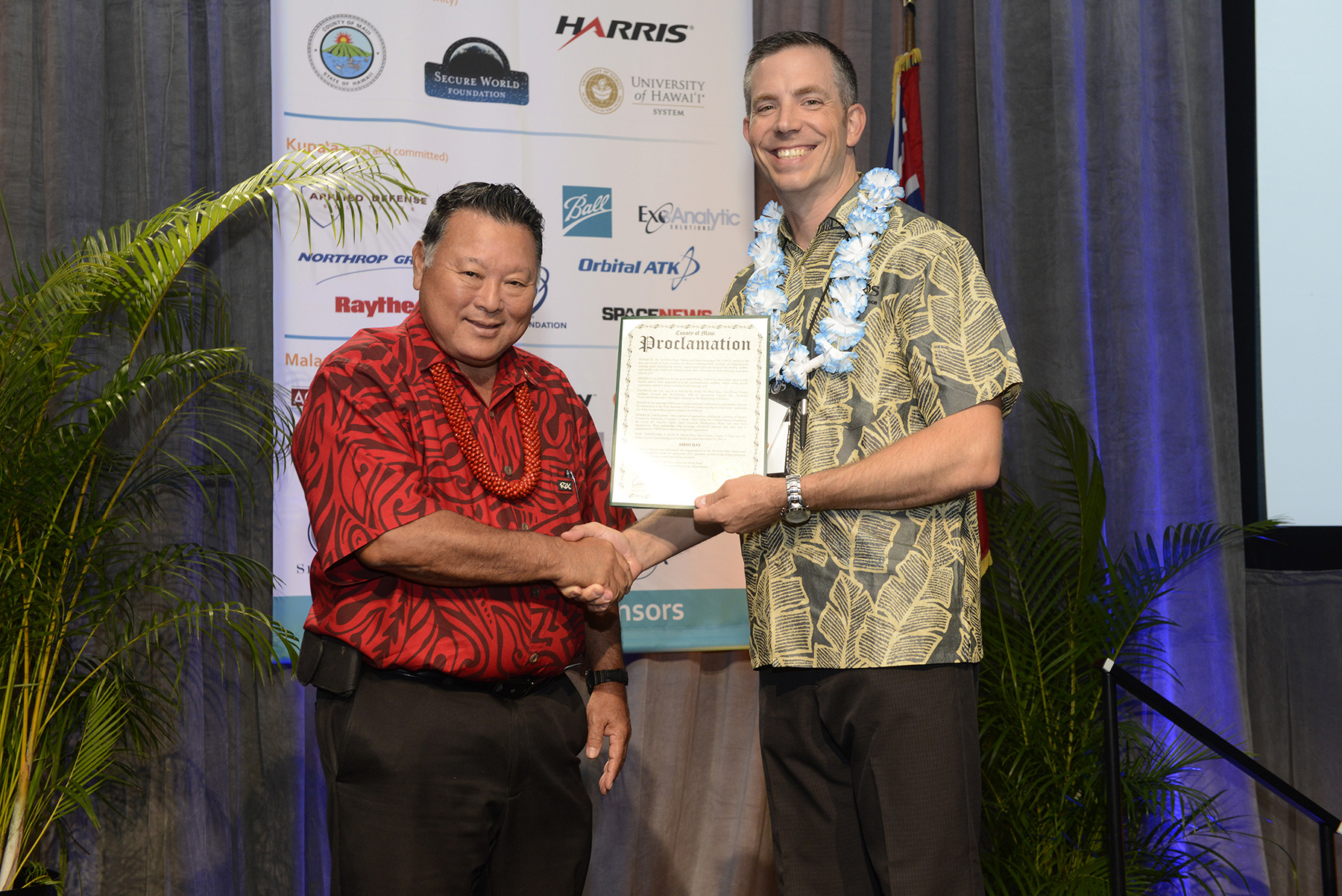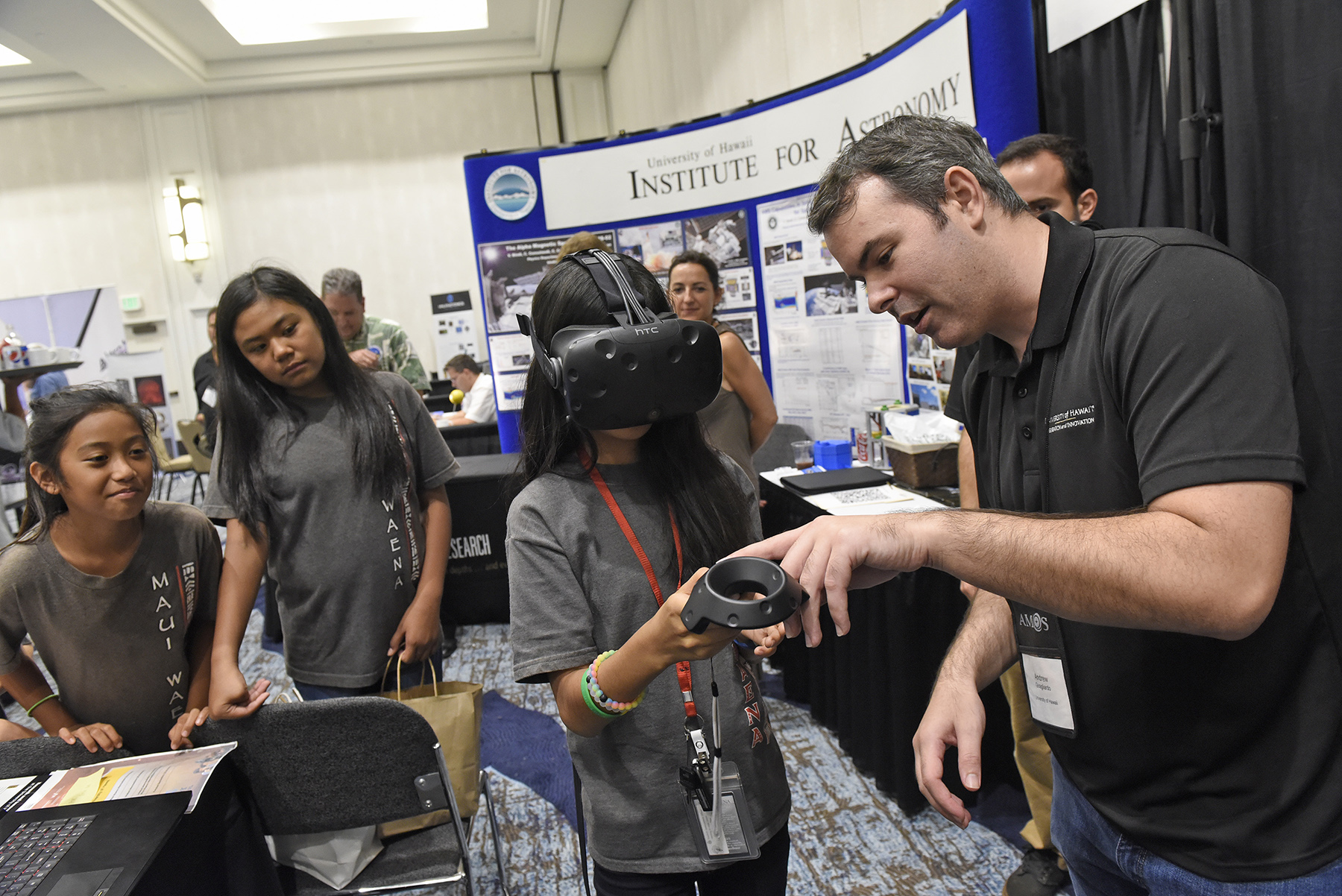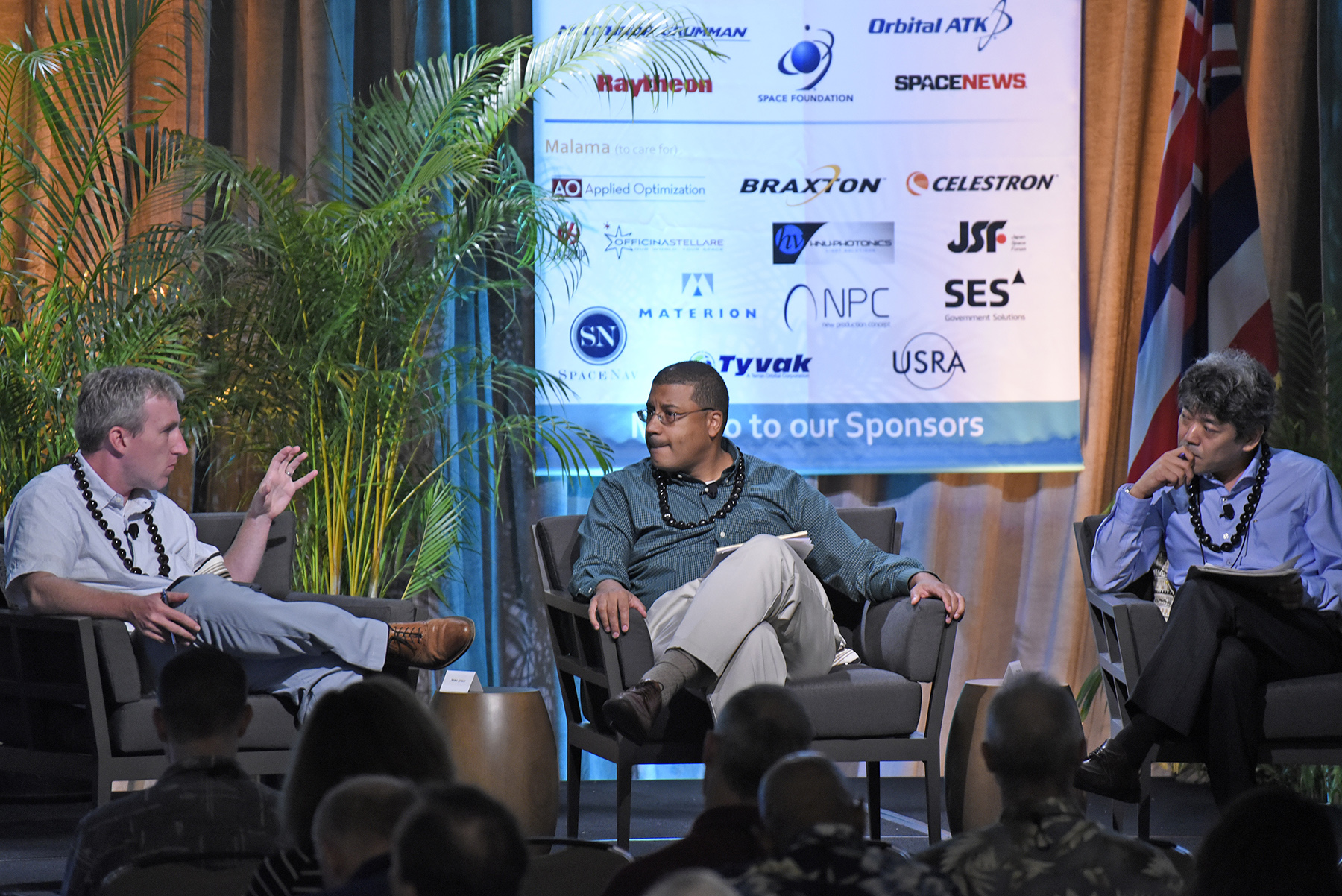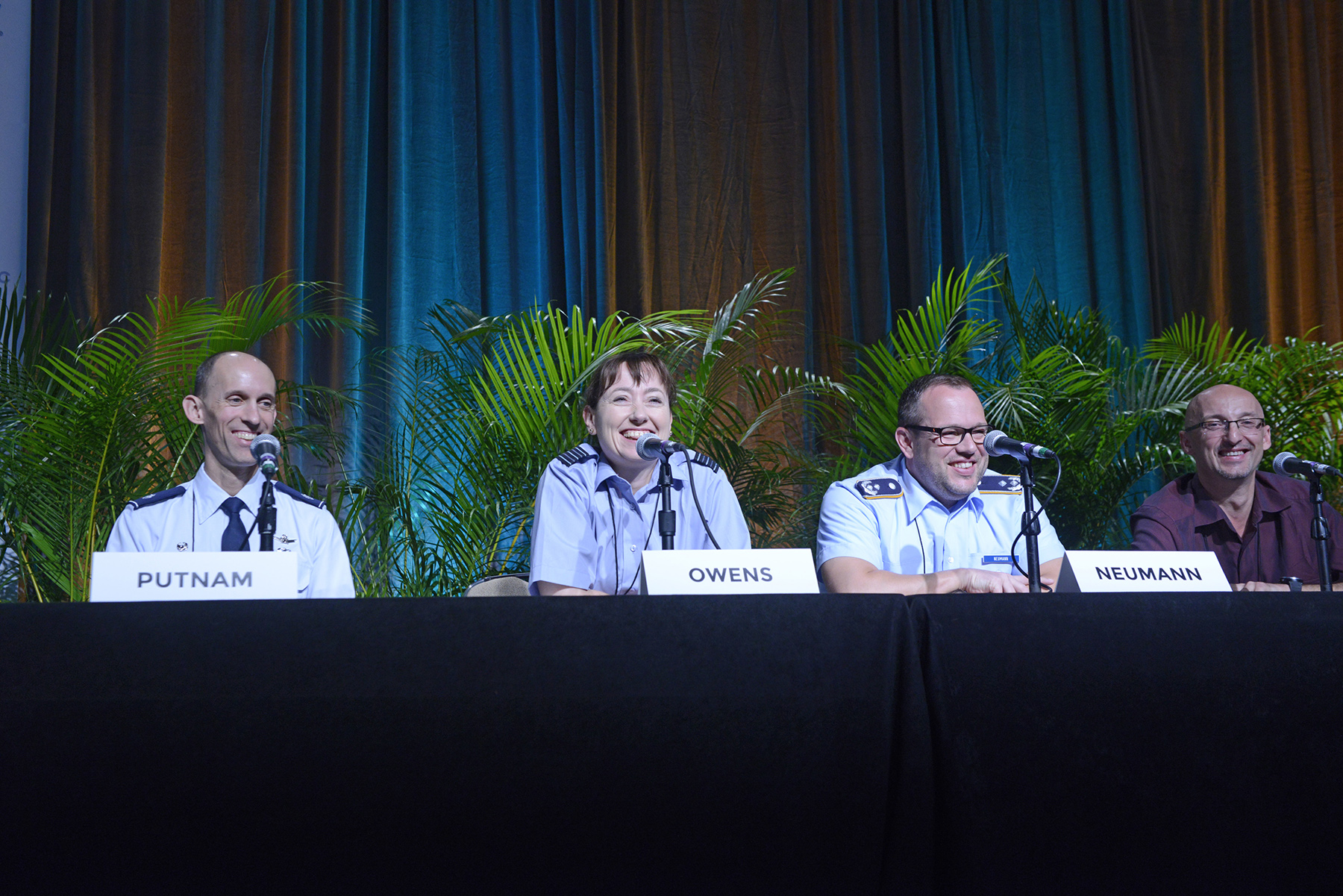Advanced Maui Optical and Space Surveillance Site Celebrates 50 Years
This year marks the 50th anniversary milestone for the Advanced Maui Optical and Space Surveillance or AMOS site. In 1966, the site was known as the Advanced Research Projects Agency Midcourse Observation Station; In 2000, AMOS became the Air Force Maui Optical Station; and today, it is the Air Force Maui Optical and Supercomputing Site.
Since AMOS’ inception, the players have changed and the facilities have been enhanced. Its mission also has evolved. However, AMOS leaders say the facility has “always been about the state-of-the-art electro-optical capabilities and dedicated, exceptional staff supporting the research and operational missions of the United States government.”
17th Annual Advanced Maui Optical and Space Surveillance Technologies Conference
The 17th Annual Advanced Maui Optical and Space Surveillance Technologies Conference was held on Sept. 20-23 at the Wailea Marriott Resort and Spa with a record-breaking attendance of over 680 participants.
A program of the Maui Economic Development Board , AMOS is the premier technical conference in the nation devoted to space surveillance. The cross section of military, contractor, and academic participation in the field of Space Situational Awareness is unmatched by any other conference in the world, as evidenced by the continued growth in attendance and sponsors and the corresponding increase in scientific excellence and collaboration.
The program presented over 100 technical papers and featured speakers, poster sessions, exhibits and short courses in the fields of telescope optics, adaptive imaging and international exchange of knowledge within the SSA community. Eighteen countries were represented, making this year’s conference a truly international event; showing the importance of satellites in our daily lives.
AMOS Contributors Honored at Banquet
On Wednesday September 21, during a banquet held in conjunction with the annual AMOS Conference, individuals who have contributed to the important activity on Maui were honored. Whether from military, civilian, or contractor organizations, they have advanced the surveillance of space and its associated tasks.
Maui Mayor Alan Arakawa presented Lieutenant Colonel Andrew Emery, commander of Air Force Research Laboratory’s Detachment 15 in Kīhei, with a proclamation at the banquet, naming September 21 as AMOS Day.
“I am so proud to accept this honor on behalf of the site, of all the people who came before us, those here now and for those yet to come,” said Lieutenant Colonel Emery. “The late Senator Inouye’s vision for the site and this proclamation are focal points for technology and innovation on the island. They provide opportunities for residents to take part in the jobs needed to support Maui’s scientific industry, in which MEDB’s pivotal role is beneficial to the whole community.”
AMOS Conference Featured Technical Short Courses
Technical short courses on Space Debris, Satellite Conjunction Assessment, and others, kicked off the conference on Tuesday September 20, with morning and afternoon sessions. “The threat of on-orbit collisions has become an increasing concern to the space- faring community,” said Lauri K. Newman, Robotic Mission Conjunction Assessment Risk Analysis Manager at NASA’s Goddard Space Flight Center, who taught a short course on the subject at the AMOS Conference.
“As space becomes more congested, the operational practice of conjunction assessment has evolved from simply predicting close approaches between orbiting objects to sophisticated systems.”
Keynote Discussion Focuses on Space Traffic Management
On opening day, Mike Gruss, senior staff writer for SpaceNews, moderated discussions with keynote speakers Major General David D. Thompson, Vice Commander of Air Force Space Command, and Mr. Douglas L. Loverro, Deputy Assistant Secretary of Defense for Space Policy.
“We must keep space safe and be prepared to operate and defend space assets for us and our allies to operate efficiently,” said Gen. Thompson. “We have to be part of the global community in space to improve our understanding of the domain.”
In agreement Loverro added, “We must rethink space traffic management to include many partners to ensure the safety of all people and nations.”
Although the topic of space traffic management is not new, it has recently seen renewed interest among satellite operators and governments. The STM forum on Wednesday, moderated by Brian Weeden, Technical Advisor for Secure World Foundation, discussed the growing international and commercial interest in space since commercial companies have announced plans to conduct space activities that challenge existing licensing and regulatory frameworks.
“At the same time, top military leaders have expressed interest in moving away from providing conjunction assessment for all satellite operators and civil agencies,” explained Weeden. “This session discussed the current status of the STM dialogue within the United States, what steps are being considered for future responsibilities and authorities, and the major questions that still need to be answered.”
“It is time for the US military to let go of the spaceflight safety mission, and allow the private sector, academia, and international partners to create its own public, high-accuracy catalog of space objects, providing safety of spaceflight services to satellite operators,” Weeden said. “Letting go of these tasks would enable the US military to focus on the national security aspects of SSA while defending against potential hostile threats to its satellites.”
International Partnerships Discussed
On Thursday, Gruss talked about International Partnerships with Frank Rose, Assistant Secretary of State for Arms Control, Verification, and Compliance, and Atsushi Saito, Director of Space Policy Division, concurrently Senior Negotiator for International Security Affairs, National Security Policy Division and Director of Cyber Security Policy Division, Foreign Policy Bureau, Ministry of Foreign Affairs, Japan.
“Due to rapid advances in technologies, space is complex and changing rapidly,” said Rose. “Because of increased congestion, dialogue and guidelines among space-faring nations are key for responsible behavior in outer space.”
Policy Forum
During the SSA Policy Forum that followed on Thursday, international SSA operators exchanged strategic policy tools for strengthening international partnerships among governments and satellite operators. In 2013, the US, the UK, Canada, Australia, and New Zealand signed the Combined Space Operations agreement intended to strengthen and enhance resilience and optimize resources.
In addition, there are also broader discussions of government-to-government sharing of SSA data to improve national security and safety of spaceflight. This session included keynotes that updated SSA policy priorities with shared insights from SSA operators on lessons learned and steps that can be taken in the future.
Moderated by Mike Wasson, Senior Director Operations, Analytical Graphics Inc., panel members Lt. Col. Rafal Borek, Chief of Section, Defence Projects, Polish Space Agency; Lt. Col Steffen Neumann, Deputy Director Operations, German Space Situational Awareness Center; Wg. Cdr. Rayna Owens, Commander, Royal Air Force Fylingdales, UK; Lt. Col. Scott Putnam, U.S. Air Force, Commander, 18th Space Control Squadron, shared their international views.
“It is always a privilege to be invited to attend AMOS,” said Owens. “This is my second time in Maui at the event and I find it an excellent forum for open, frank, and honest dialogue with a range of military, civil, commercial and academic colleagues.”
Owens continued saying, “We share a common international challenge in understanding the evolving space domain and the threats and risks contained within it, and I believe that we all seek to ensure and preserve the domain for future generations. Maui provides a stunning backdrop for what is, in my experience, a great opportunity for the international dialogue that is so vital to space operations.”
“We can’t do it alone,” explained Neumann. “All my training experiences have proved that we need international cooperation and partnerships with all nations to ensure peaceful and lasting capabilities.”
The final keynote was given on Friday by Jordi Puig-Suari, Professor, CubeSat Program, Cal Poly State University and CEO of Tyvak Nano-Satelllite Systems, Inc. He discussed SSA in relation to small satellites.
Small Satellites
Over the last several years, “smallsats” have transitioned from lab experiments to viable space platforms. Thousands of small satellites are currently planned to be deployed into a wide range of orbits. An increasing number of them are being built as 10-centimeter cubes, “cubesats”, which are nevertheless fully functional satellites.
While the surge in smallsats is increasing the rate of innovation and lowering the costs of deploying space capabilities, they also present challenges. They can be more difficult to track and identify, particularly when deployed in large numbers at once, and they often lack maneuvering capabilities. Operators of larger satellites have expressed concerns that large numbers of non-maneuverable smallsats could create unmanageable traffic problems in space.
“We need to change our attitude about cubesats,” said Bhavya Lal, a research staff member at the Institute of Defense Analyses’ Science and Technology Policy Institute, during one of the first panel discussions between the SSA community and the small satellite proponents. “They are a very important part of our satellite population because they can carry out important missions in spite of being small.”
Puig-Suari added, “The space community will be surprised at the amount of help smallsats will be in the future. They can meet regular spacecraft expectations, enhance space-based SSA, be active in space debris removal, and contribute solutions to problems that can’t be solved with larger spacecraft.”
Maui Students Highlighted at Sold-Out Exhibit and Poster Venue
The sold-out exhibit and poster venue at AMOS provided opportunities for networking and technical discussions, offering updates and assessments of current research in the different SSA fields, such as space weather and related specialties in astronomy.
One hundred Maui middle school students participated in hands-on STEM (science, technology, engineering, and mathematics) activities during the Space Exploration Student Session at AMOS. They were introduced to space technologies via exhibits and hands-on projects and had the opportunity to meet industry professionals and learn valuable lessons in STEM subjects.
“I enjoyed learning and talking to the experts at the AMOS Conference,” said Czerena Martinne Boyle, Maui Waena Intermediate School 8th grader. “My favorite booth was SatWatch, a virtual reality exploration of satellite orbits around the Earth. I got to explore SSA data in an immersive experience of orbits of a wide variety of satellites. These satellites make a big impact on the community and in the world for national security, internet, banking, telephones, television, navigation, scientific exploration and more.”
“I’ve attended many outstanding teacher workshops at the AMOS conferences but the 2016 conference was extra special,” said Debbie Hisashima, academic coach and MEDB Women in Technology Project’s STEMworks™ AFTERschool coordinator at Pukalani Elementary School. “This year I got to experience it through the eyes of the children. With the support of MEDB, 20 excited students from Pukalani Elementary School were able to learn outside of their classroom walls. They programmed robots, manipulated the refraction of light, and learned about things they never knew existed”
“The teachers, students, and parents of Pukalani Elementary School thank MEDB for taking our learning up the skies, for growing imaginations, and for opening doors of future possibilities!” exclaimed Hisashima.

Mayor Alan Arakawa and Lieutenant Colonel Andrew Emery commander of Air Force Research Laboratory’s Detachment 15 in Kihei, with a proclamation naming September 21 as AMOS Day.

Students explored SSA data in an immersive experience of orbits of a wide variety of satellites. These satellites make a big impact on the community and in the world for national security, internet, banking, telephones, television, navigation, scientific exploration and more. Pictured (L-R) are: Maui Waena students Glenzy Salcedo, Samantha Della and Emily Tom, and Andrew Guagliardo, Undergraduate, LAVA program, UH Mānoa.

Gruss (left) talked about International Partnerships with Frank Rose (center), Assistant Secretary of State for Arms Control, Verification, and Compliance, and Atsushi Saito (right), Director of Space Policy Division, concurrently Senior Negotiator for International Security Affairs, National Security Policy Division and Director of Cyber Security Policy Division, Foreign Policy Bureau, Ministry of Foreign Affairs, Japan.

Lt. Col. Scott Putnam, U.S. Air Force, Commander, 18th Space Control Squadron; Wg. Cdr. Rayna Owens, Commander, Royal Air Force Fylingdales, UK; Lt. Col Steffen Neumann, Deputy Director Operations, German Space Situational Awareness Center; and Lt. Col. Rafal Borek, Chief of Section, Defence Projects, Polish Space Agency shared their views on international collaboration.












